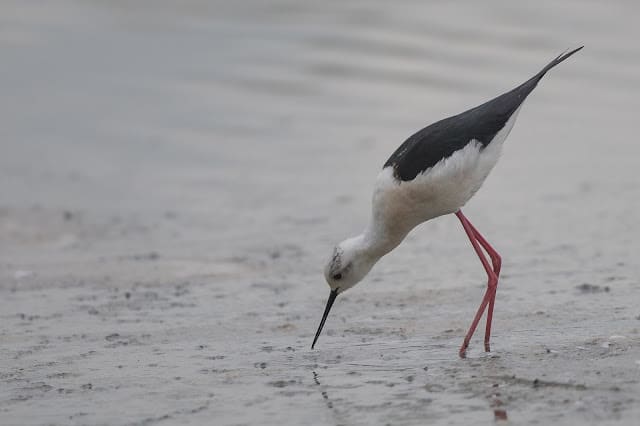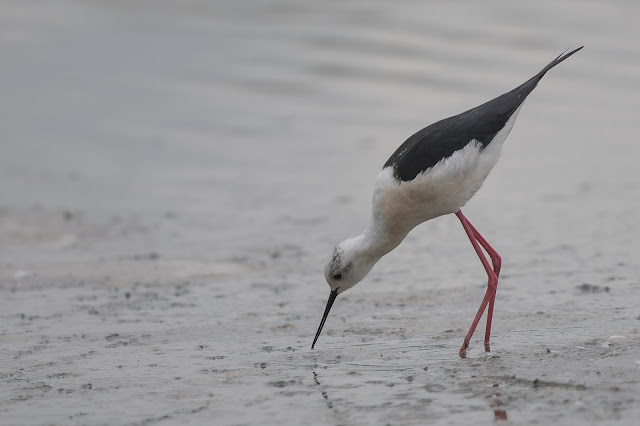We had a weekend at the cottage in the Cotswolds planned but there was to be little time for birding – I need brownie points for an up coming trip! Still, I managed to convince Sarah that a trip to Slimbridge might be nice and she duly arranged to meet with her sister so that Tobias could play with his cousins.
My motive was a pair of Black-winged Stilt that had set-up territory on the South Lake and were showing well from the Discovery Hide. So after saying my ‘hello’s’ to relatives I snuck to the Discovery Hide where the stilts were immediately on show no more than 30 metres from the hide. I watched these fantastic birds over the next couple of hours while they fed and often mated around the South Lake.
The female was clearly smaller and far browner than the male with a darker head and a great deal of flecking. The male, in contrast, was glossy black above with a largely white head and neck and a distinctive pinkish flush on the breast.
Male Black-winged Stilt – South Lake, Slimbridge WWT
Female Black-winged Stilt – South Lake, Slimbridge WWT
Male Black-winged Stilt – South Lake, Slimbridge WWT
Male Black-winged Stilt – South Lake, Slimbridge WWT
Male Black-winged Stilt – South Lake, Slimbridge WWT
Male Black-winged Stilt – South Lake, Slimbridge WWT
Male Black-winged Stilt – South Lake, Slimbridge WWT
Male Black-winged Stilt – South Lake, Slimbridge WWT
Black-winged Stilt – South Lake, Slimbridge WWT
Male Black-winged Stilt – South Lake, Slimbridge WWT
Female Black-winged Stilt – South Lake, Slimbridge WWT
Female Black-winged Stilt – South Lake, Slimbridge WWT
Female Black-winged Stilt – South Lake, Slimbridge WWT
Female Black-winged Stilt – South Lake, Slimbridge WWT
Male Black-winged Stilt – South Lake, Slimbridge WWT
Male Black-winged Stilt – South Lake, Slimbridge WWT
There wasn’t much else on the South Lake except for at least 18 Avocet and a Greenshank.
Avocet – South Lake, Slimbridge WWT
Avocet – South Lake, Slimbridge WWT
Avocet – South Lake, Slimbridge WWT
Avocet – South Lake, Slimbridge WWT
Avocet – South Lake, Slimbridge WWT
Avocet – South Lake, Slimbridge WWT
Cormorant and Mallard – South Lake, Slimbridge WWT
Tufted Duck – South Lake, Slimbridge WWT
Tufted Duck – South Lake, Slimbridge WWT
A short trip to the Zeiss Hide to look for a Great-white Egret produced several hundred Black-tailed Godwit, a flock of eight Ruff with one bird almost in full summer plumage, four Reed Warbler and two Swallow but no sign of the egret.
Mixed flock of Black-tailed Godwit and eight Ruff. The bird, sixth from left, is a very dark Ruff almost in summer plumage and was widely being claimed as a Spotted Redshank! – Zeiss Hide, Slimbridge
Simon Colenutt
I began birdwatching at the age of nine when living on the Isle of Wight. After obtaining a copy of the Isle of Wight Bird Report from 1976 I realised that Manx Shearwater, Arctic Skua, Pomarine Skua and Black Tern were regularly seen at St.Catherine's Point, only five miles from my home village of Chale Green. To a nine year old these birds were near mythical and so I just had to go and try to see them. Little did I know that these birds were seasonal and after a long winter of seeing nothing I eventually started to bump into other birdwatchers as March drew to a close. It was then that Dave Hunnybun, Dave Wooldridge, Paul Castle, Peter Gandy and Audrey Wilkinson introduced me to the art of seawatching and the joys of bird migration, I have not looked back since.



























Leave a Reply